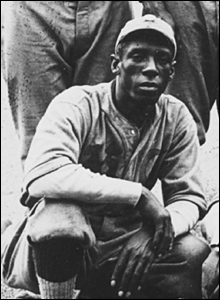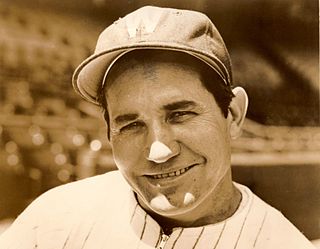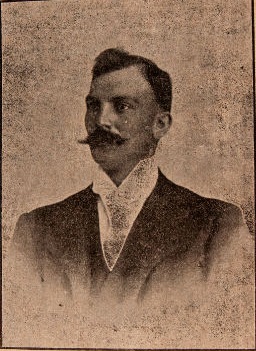Related Research Articles

Adolfo Domingo De Guzmán "Dolf" Luque was a Cuban starting pitcher in Major League Baseball (MLB) from 1914 to 1935. Luque was enshrined in the Cuban Baseball Hall of Fame in 1957 and the Cincinnati Reds Hall of Fame in 1967, as well as in the Mexican Baseball Hall of Fame in 1985. Luque was not only the first White Hispanic pitcher in MLB, but also the first to win a World Series victory, and the first to lead the Leagues in wins and shutouts.

Cristóbal Torriente called Babe Ruth of Cuba , was a Cuban outfielder in Negro league baseball with multiple teams. He played from 1912 to 1932 and was primarily a pull hitter, though he could hit with power to all fields. He had a stocky and slightly bowlegged build, but was known for deceptive power and a strong, accurate arm from center field. Indianapolis ABC's manager C.I. Taylor stated, "If I see Torriente walking up the other side of the street, I would say, 'There walks a ballclub.'" Torriente was elected into the National Baseball Hall of Fame in 2006.

Miguel Angel González Cordero was a Cuban catcher, coach and interim manager in Major League Baseball (MLB) during the first half of the 20th century. Along with Adolfo Luque, González was one of the first Cubans or Latin Americans to have a long career in the American major leagues.

José Colmenar del Valle Méndez was a Cuban right-handed pitcher and manager in baseball's Negro leagues. Born in Cárdenas, Matanzas, he died at age 43 in Havana. Known in Cuba as El Diamante Negro, he became a legend in his homeland. He was one of the first group of players elected to the Cuban Baseball Hall of Fame in 1939. He was elected to the National Baseball Hall of Fame and Museum in 2006.
The Cuban League was one of the earliest and longest lasting professional baseball leagues outside the United States, operating in Cuba from 1878 to 1961. The schedule usually operated during the winter months, so the league was sometimes known as the "Cuban Winter League." It was always a small league, generally 3 to 5 teams, and was centered in Havana, though it sometimes included teams from outlying cities such as Matanzas or Santa Clara. The league became racially integrated in 1900, and during the first half of the 20th century the Cuban League was a premier venue for black and white players to meet. Many great black Northern American players competed in Cuba alongside native black and white Cuban stars such as José Méndez, Cristóbal Torriente, Adolfo Luque, and Martín Dihigo. After 1947, the Cuban League entered into an agreement with Major League Baseball and was used for player development. Following the 1959 Cuban Revolution, however, tensions rose with the new Communist government, and in March 1961 the government decreed the abolition of professional baseball.

The Habana B.B.C. also known as the Habana Reds or, later, the Leones del Habana was one of the oldest and most distinguished baseball teams in the old Cuban League, which existed from 1878 to 1961. Habana, representing the city of Havana, was the only team to play in the league every season of its existence and was one of its most successful franchises. In their early history they were known by their colors as the Reds; later they adopted the names of Leones or Lions. Throughout their existence they had a famous rivalry with Almendares.

The Almendares B.B.C., also known as the Alacranes del Almendares, was one of the oldest and most distinguished baseball teams in the old Cuban League, which existed from 1878 to 1961. Almendares represented the Almendares District on the outskirts of the old city of Havana—when the league was founded it was still considered a suburban area, but later became a district within the enlarged city. Almendares was one of the most successful franchises in the Cuban League. In their early history they were known by their colors as the Blues; later they adopted the name of Alacranes. Throughout their existence they had a famous rivalry with the Habana baseball club.
The Philadelphia Giants were a Negro league baseball team that played from 1902 to 1911. From 1904 to 1909 they were one of the strongest teams in black baseball, winning five eastern championships in six years. The team was organized by Sol White, Walter Schlichter, and Harry Smith.

Conrado Eugenio Marrero Ramos, nicknamed "Connie", was a Cuban professional baseball pitcher. The right-handed Marrero pitched in Major League Baseball from 1950 to 1954 for the Washington Senators. Marrero made his major league debut when he was 38 years old, and was one of the oldest players in the league throughout the duration of his time in the major leagues. He was a popular star in his native Cuba, where he had a long and successful career in amateur baseball, pitching for Cuba in several Amateur World Series competitions, and playing several excellent seasons with the professional Cuban League and the minor league Havana Cubans. His nicknames in Cuba were "El Guajiro de Laberinto", reflecting his rural origins, "El Premier", and "El Curvo."

William S. Monroe was an American infielder in baseball's Negro leagues. He was also known by the nickname of "Money." During a 19-year career from 1896 to 1914, he played on many of the greatest teams in black baseball. He was a good hitter and slick fielding third base and second baseman who was compared to major league star Jimmy Collins. Monroe played all four infield positions, but spent his prime seasons at third base and second base.
The Lincoln Stars were a Negro league baseball team that played in New York City from 1914 to 1917. Their home stadium was the Lenox Oval, located at Lenox Avenue and 145th Street in Manhattan. Although they lasted less than four years, they were a good team that featured three players who would later be elected to the National Baseball Hall of Fame—Oscar Charleston, John Henry Lloyd, and Louis Santop.

José Rodríguez, nicknamed "Joseíto" or "El Hombre Goma" in Spanish and "Joe" in English, was a Cuban infielder who played in Major League Baseball from 1916 to 1918 and in the Cuban League from 1914 to 1939. In the majors, he played for the New York Giants and was primarily a second baseman, while in the Cuban League and the U.S. minor leagues he mostly played first base. A defensive specialist, according to Roberto González Echevarría, Rodríguez "was considered the best defensive first baseman in Cuba" of his time. He was also a long-time manager in the Cuban League and managed for one season in the minors. He was inducted into the Cuban Baseball Hall of Fame in 1951.
The Leopardos de Santa Clara were a Cuban professional baseball team based in Santa Clara, Cuba. Founded in 1922, they played in the Cuban League from 1922 to 1925, from 1929 to 1930, and from 1935 to 1941. Although they competed for only 11 seasons, they won league championships in four regular seasons and in one "special season." According to Cuban League historian Jorge S. Figueredo, the 1923/24 team, which went 36–11 and won the championship by 11+1⁄2 games, is "considered as the most dominant team in the history of Cuban baseball."
Club Fé was a Cuban baseball team based in Havana in the Cuban League. It played in 1882, 1885, from 1887 to 1890, and again from 1901 to 1914.

Antonio María García Callaghan, nicknamed "El Inglés", was a Cuban baseball catcher in the Cuban League. He played from 1882 to 1905 with several Cuban ballclubs, including Almendares, the Fe club, Habana, and the All Cubans. He was elected to the Cuban Baseball Hall of Fame in 1939.

Moisés Quintero Cavada was a Cuban baseball catcher in the Cuban League and Negro leagues. He played from 1887 to 1904 with Habana, Progreso, Almendares, the All Cubans, and Club Fé. He was elected to the Cuban Baseball Hall of Fame in 1953.
The Long Branch Cubans were a professional baseball team that played from 1913 to 1916. It was the first U.S. minor league baseball team composed almost entirely of Cubans. Several players, including Dolf Luque and Mike González, went on to play in the major leagues. The Cubans played in Long Branch, New Jersey from 1913 to 1915, except for the first half of the 1914 season, when they played in Newark, New Jersey. In 1916, they started the season playing in Jersey City, New Jersey as the "Jersey City Cubans." Later that summer, they moved their home games to Poughkeepsie, New York, where they were usually referred to as the "Long Branch Cubans." In late July 1916 they briefly moved to Harlem and finally to Madison, New Jersey in August.

Andrés Fleitas [flei'-tasz] was a professional Cuban baseball catcher and first baseman. Listed at 5' 11", 175 lb., he batted and threw right handed.

Eleno Agapito Mayor Valenzuela was a Cuban professional baseball pitcher. Listed at 5' 11", 185 lb., he batted and threw left handed.

José Leblanc Vargas, nicknamed "Cheo" and "Count", was a Cuban baseball pitcher in Negro league baseball. He played most of his career with the midwestern Cuban Stars, including in the first two seasons of the original Negro National League. His career earned run average of 2.31, as well as 7.8 wins above replacement (WAR) per 162, are among the best marks for qualified pitchers in the recognized Negro major leagues.
References
- Figueredo, Jorge S. (2003), Cuban Baseball: A Statistical History, 1878–1961, Jefferson, North Carolina: McFarland & Company, ISBN 078641250X
- Nieto, Severo (2008), Early U.S. Blackball Teams in Cuba, Jefferson, North Carolina: McFarland & Company, ISBN 978-0-7864-1928-9
- Tygiel, Jules (1983), Baseball's Great Experiment: Jackie Robinson and His Legacy , New York: Oxford University Press, ISBN 0195033000
